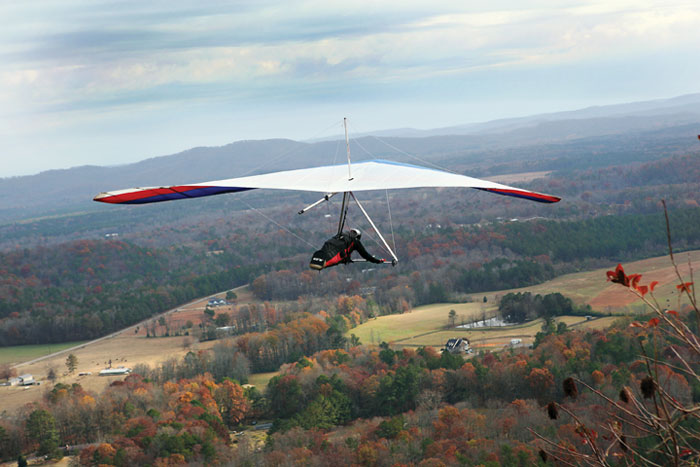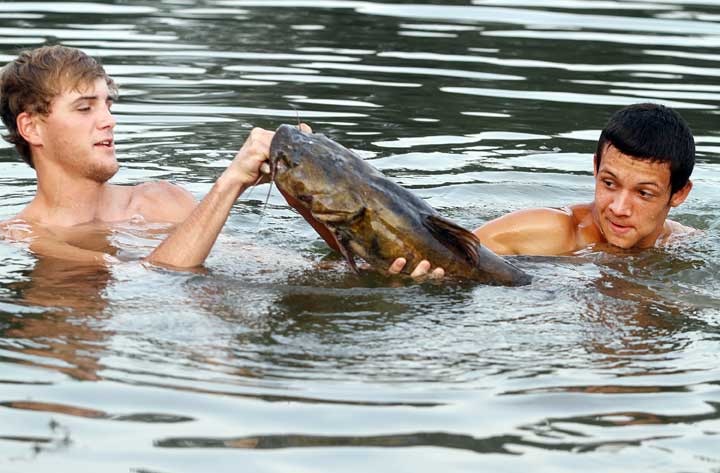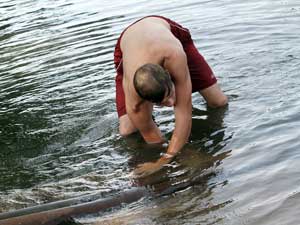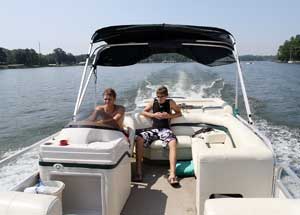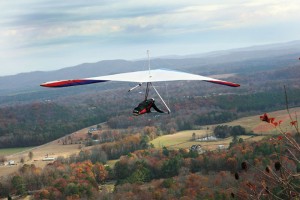 St. Clair residents revel in the thrill of hang gliding
St. Clair residents revel in the thrill of hang gliding
Story by Loyd McIntosh
Photos by Jerry Martin
Since the time the first human being turned his eyes upward and saw a strange-featured creature flapping its wings in the air, mankind has dreamed of flying. For thousands upon thousands of years, fulfillment of that dream remained elusive, even as Homo sapiens conquered practically everything else. But a millennia of frustration, experimentation and spectacular failure was erased when a couple of bicycle builders from North Carolina named Orville and Wilbur became the first humans to achieve flight a little more than 109 years ago.
Since then, flying has become, for the most part, ho-hum. Routine. Another day at the office for millions of people traveling from meeting to meeting, airport to airport every single day; security checks in shoeless feet with unfamiliar hands getting a little too familiar.
If this experience makes you want to jump off the nearest cliff, rest assured, you’re not alone. But, before you leap, be sure to strap a giant kite to your back and get ready to really experience the miracle of flight. Some people might consider this method of flight, known as hang gliding, to be a little dangerous and a whole lot of crazy, but to a handful of St. Clair County residents, hang gliding is one heck of a thrill.
“It’s awesome,” said Bill Turner, a Springville resident and a dentist in Center Point. Turner at first glance may appear rather conservative and measured for the risky sport of hang gliding. But this self-described extreme sports enthusiast was introduced to hang gliding back in 1999 and almost 13 years later, hasn’t yet become bored with the feeling and excitement he gets from flying.
“My best description is if you can remember the dreams you had when you were a young child where you were just flying. You know, arms out flying around over things,” he said. “If you take that and put a small fan in front of your face to blow air on you, that’s what it’s like.”
Turner is part of a group of local gliders who are members of the Alabama Hang Gliding Association, a group started by another St. Clair County resident and avid glider, Phillip Dabney, back in 1980. The group has seen some ups and downs among its membership ranks over the years, but throughout the winter and spring, dozens of hang gliders from around the state make their way to launch sites dotting ridges and cliffs along Chandler Mountain.
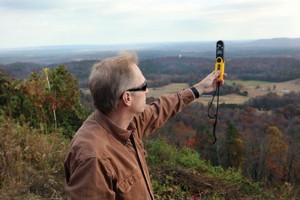 Peaking at an elevation of 1,529 feet and overlooking Springville on one side and Oneonta in Blount County on the other, the mountain is a popular spot for hang gliders hungry for a place close to home to pursue their passion, even if it means having to pack up their gear with little advanced planning. “I started my own landscaping company in order to have more flexible hours and to be able to go hang gliding at a moment’s notice,” said Dabney, who lives close to his favorite launch point on Chandler Mountain near Springville. He and Turner say the challenge is the unpredictable nature of the weather patterns on the mountain.
Peaking at an elevation of 1,529 feet and overlooking Springville on one side and Oneonta in Blount County on the other, the mountain is a popular spot for hang gliders hungry for a place close to home to pursue their passion, even if it means having to pack up their gear with little advanced planning. “I started my own landscaping company in order to have more flexible hours and to be able to go hang gliding at a moment’s notice,” said Dabney, who lives close to his favorite launch point on Chandler Mountain near Springville. He and Turner say the challenge is the unpredictable nature of the weather patterns on the mountain.
“Everything is sort of determined by the wind and the weather,” Turner explained. “That ridge happens to face southeast, which means in the winter time, when we have those unseasonably warm days — 65 degrees, when normally it’s been 40 all week long — you get the wind blowing out of the southeast that takes that Florida air and warms the area around here and makes it delightful for us to fly.
“You want the wind to blow into the ridge and be deflected upward so when you launch, you’ll get up in that airlift that’s running along the ridge and then from that you can run into thermals and get up much higher,” he added.
Turner caught the hang gliding bug a dozen years ago after agreeing to accompany his brother, Jim, to Lookout Mountain near Chattanooga, home of some spectacular flying and where one of the nation’s best hang gliding schools happens to be located. Turner said his brother asked him to come along and take some photos during a tandem flight with an instructor. Initially believing his brother had gone a little loco in the dome, Turner agreed to go and brought his youngest son, Grant, along. Before he knew it, his son was wanting to fly. Turner suddenly realized he had a decision to make.
“So, we get up there and I sign him up and I’m thinking, ‘I’m going to have to come back here next Saturday and fly if the world finds out that my youngest son and my brother flew and I didn’t,” Turner recalled. “So, I plopped down another $125 and signed up for it.”
Before Turner could fly that morning, a warm weather storm came through, and his turn was postponed until the afternoon. By then, the choppy winds from the early morning were long gone. The conditions couldn’t have been more perfect. “My first flight was in air that had been calmed by the rain and was perfectly smooth, and I mean it just hooked me right in. It was so smooth, so nice and so much fun,” he said. That was in October 1999. “I’ve loved it ever since.”
Before long, Turner graduated from tandem flights to solo hang gliding and is now a tandem instructor himself. He said the thrill he received from hang gliding was so intense that it may have affected his judgment once in a while as a new pilot. However, even the most experienced pilots can have a close call or two — jumping off a cliff always comes with a certain amount of risk. Turner said he’s learned to dial back the adrenaline-junkie side of his personality over time.
“I probably let my love for it interfere with my common sense,” he said with a laugh. “I think I’m a little wiser now than I was then, but it gets in your system, and you love it so much that you just have to go every weekend.
“I’ve had a few close calls, more than I’d like to admit. Every pilot that has flown has had some close calls,” he noted. “There is a saying in aviation, ‘There are old pilots, there are bold pilots, but there are no old, bold pilots.’”
St. Clair County really is a sportsman’s paradise with plenty of lakes and acres upon acres of undisturbed land to take in and experience nature. But, Turner said, there is simply nothing like experiencing the surrounding area from the air silently and without so much as a windshield between the pilot and the world.
“We have lots of interaction with birds of prey up there. Not necessarily intentionally,” he said. “One of the things we look for when we try to find rising air is a bird, usually it’s a turkey vulture, but sometimes there are eagles or falcons, all sorts of birds like that, that will be circling, and we head into that air and try to get with them.
“Many times I have launched from Springville, and I have been on the wingtip of an eagle, and we’re circling each other. It is absolutely amazing. Sometimes we come up on birds that will be doing the ridge lift and really you’re just a few feet from them. Literally, I’ve been within 3 feet of a big bird, wings all the way out, and I could have reached out and touched it if I had wanted to,” Turner said. “The beauty up in the sky, particularly if you’re flying late at night and the sun is setting, is just amazing. And when the air smooths out, there are times when you can really fly with just two fingers on that control bar. It really is wonderful.”
For Dabney, who has been flying for almost 35 years, one of his favorite memories involved experiencing a certain weather phenomenon most people only hear about from meteorologists.
“I was flying with a friend over Blount Mountain. We were about 2,000 feet over the top of the mountain and flew out over the Big Oak Girls Ranch, and it started snowing. As we got lower, it turned to sleet then light rain,” Dabney said. “By the time we landed in the Washington Valley it was sunny, and none of the precipitation had made it to the ground. It had all evaporated in a drier layer of air near the ground. This phenomenon is called ‘virga.’ You may have heard (TV meteorologist) James Spann mention it.”
Regardless of the reasons for flying, which mountain you launch from, or whether it’s a tandem flight or solo, Turner said the idea of flying thousands of feet above the earth with only a helmet for protection is a buzz that never gets old. “There’s something incredibly exciting about having that big kite on your back, rolling down a hill, and realizing that you’re the only one controlling that thing.
“It’s so simple. It’s just pure flight.”














